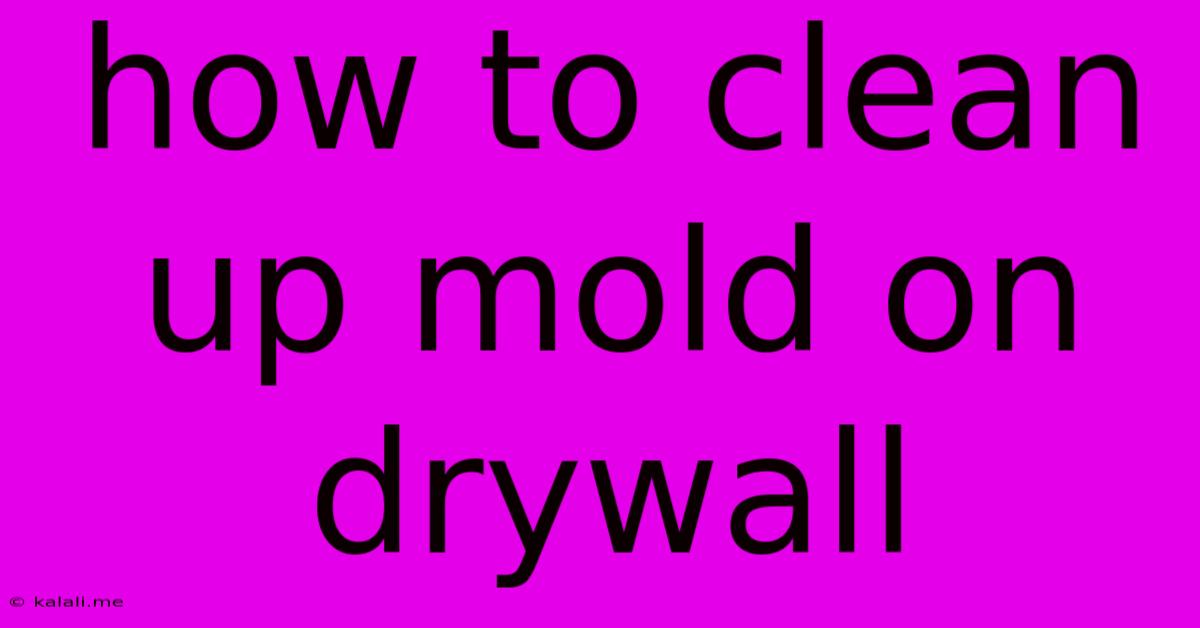How To Clean Up Mold On Drywall
Kalali
Jun 08, 2025 · 3 min read

Table of Contents
How to Clean Up Mold on Drywall: A Comprehensive Guide
Mold on drywall is a serious issue, impacting both the aesthetics and the health of your home. This comprehensive guide will walk you through the safe and effective methods for cleaning up mold on drywall, from identifying the problem to preventing future growth. Ignoring mold can lead to serious health problems and structural damage, so prompt action is crucial.
Identifying Mold Growth on Drywall
Before you begin cleaning, it's crucial to accurately identify the presence of mold. Mold often presents as discolored patches, usually black, green, gray, or white. It can have a musty odor, a key indicator of its presence, even if the visual signs are subtle. Pay close attention to areas with high humidity, such as bathrooms, kitchens, and basements. If you suspect mold growth, especially if it's extensive or you notice health issues (allergies, respiratory problems), consider consulting a professional mold remediation specialist.
Assessing the Extent of Mold Damage
The amount of mold will determine your cleaning approach. Small patches of mold (less than 10 square feet) can often be handled with DIY methods. However, larger infestations or mold that has penetrated deeply into the drywall require professional help. If you're unsure, it's always best to err on the side of caution and call a professional. They have the expertise and equipment to handle extensive mold problems safely and effectively.
Cleaning Small Mold Patches on Drywall: A Step-by-Step Guide
For small mold infestations, follow these steps:
- Safety First: Protect yourself with appropriate personal protective equipment (PPE), including rubber gloves, eye protection, and an N95 respirator mask. Mold spores can be harmful if inhaled.
- Prepare the Area: Ventilate the room thoroughly by opening windows and doors. Cover the surrounding area with plastic sheeting to prevent mold spores from spreading.
- Gather Supplies: You'll need a scrub brush, a spray bottle, a solution of one cup of bleach to one gallon of water, and clean cloths or sponges. Avoid using ammonia-based cleaners, as they can react with bleach.
- Apply the Solution: Gently spray the bleach solution onto the affected area, ensuring the mold is thoroughly saturated. Let it sit for 10-15 minutes to allow the bleach to kill the mold.
- Scrub the Mold: Use the scrub brush to gently scrub the affected area, removing the mold. Work carefully to avoid damaging the drywall.
- Rinse and Dry: Rinse the area thoroughly with clean water and allow it to air dry completely. Use fans to expedite the drying process.
- Dispose Properly: Carefully dispose of all cleaning materials and protective gear according to local regulations. Never pour bleach down the drain.
Preventing Future Mold Growth
Mold thrives in damp environments. Addressing the root cause of moisture is essential for preventing future mold growth. This includes:
- Repairing Leaks: Promptly fix any leaks in roofs, pipes, or windows.
- Improving Ventilation: Ensure adequate ventilation in bathrooms and kitchens by using exhaust fans.
- Reducing Humidity: Use a dehumidifier, especially in damp areas, to lower humidity levels.
- Regular Cleaning: Regularly clean and disinfect areas prone to mold growth.
- Proper Maintenance: Maintain gutters and downspouts to prevent water damage.
When to Call a Professional
While DIY methods are suitable for small mold problems, there are situations where professional help is necessary:
- Large infestations: If the mold covers a significant area (more than 10 square feet).
- Mold penetration: If the mold has penetrated deeply into the drywall or other building materials.
- Health concerns: If you experience health problems related to mold exposure.
- Uncertainty: If you're unsure about how to safely and effectively handle the mold problem.
Remember, tackling mold correctly is essential for both your health and the structural integrity of your home. Prioritize safety and don't hesitate to call a professional when needed.
Latest Posts
Latest Posts
-
Clogged Kitchen Sink With Garbage Disposal
Jun 08, 2025
-
How To Connect Guitar To Computer
Jun 08, 2025
-
How Can I Rotate A Video In Vlc
Jun 08, 2025
-
How To Get Rid Of Moisture In Headlights
Jun 08, 2025
-
Its Just A Very Powerful Word
Jun 08, 2025
Related Post
Thank you for visiting our website which covers about How To Clean Up Mold On Drywall . We hope the information provided has been useful to you. Feel free to contact us if you have any questions or need further assistance. See you next time and don't miss to bookmark.